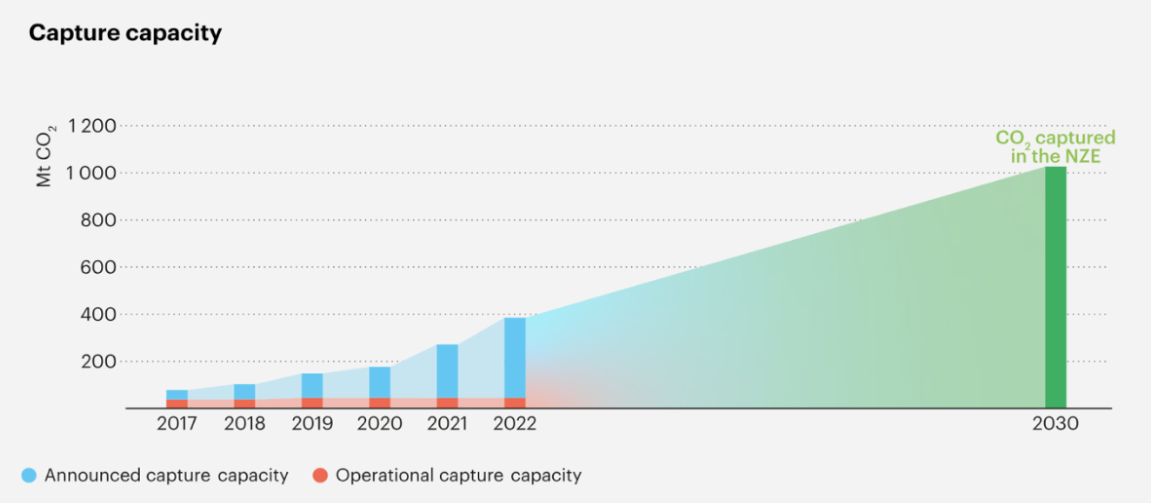This is why carbon capture and storage is the third road to net zero


· 4 min read
Carbon Capture and Storage (CCS) is experiencing a resurgence driven by the need to decarbonize heavy industry and produce blue hydrogen. Multiple large-scale projects are emerging, supported by new measures and evolving economic conditions, making CCS a much more viable short-term solution than ever before.
Recent developments have been highly encouraging for those following carbon capture and storage. The UK and the US have committed significant financial support to large-scale CCS projects, with the Inflation Reduction Act emphasizing CCS through tax breaks and investments. Major projects in the Netherlands and Norway have received funding in the European Union. According to the International Energy Agency (IEA), CCS projects are accelerating globally, a crucial step toward achieving net-zero emissions. For the first time, there is even an outlook that the net zero scenario (NZE) will be achieved if all announced projects go through. Of course, this will not happen as not all these projects will be realized, but we have never been at this point for CCS before!
In my previous column, I discussed CCS's initial promise and subsequent stagnation. Early efforts focused on applying capture technology to the power sector, but complexity, scale, and declining renewable electricity costs hindered progress. Apart from a few large-scale demonstration plants, such as Boundary Dam 3 in Canada, the sector saw little advancement.
The CCS revival stems from recognizing that, while renewable electricity developments made CCS unnecessary for the power sector, heavy industry and chemicals remain hard to abate. Fuel switching and CCS are the only viable options for rapid decarbonization at reasonable costs. Electrifying heavy industry is complex and strains electricity grids, while alternatives like hydrogen and biomethane are currently impractical due to limited supply.
The emerging hydrogen economy also boosts CCS through blue hydrogen production, where CO2 is captured and stored during natural gas cracking. Even small-scale blue hydrogen production can drive CCS adoption.
CCS technology, typically costing 60-120 euros per ton, is becoming more economically viable. The ETS price hovers around 90 euros per ton, and the Inflation Reduction Act in the US provides substantial incentives. These dynamics make many CCS applications economically feasible, spurring current and planned projects.
For CCUS to materialize, the entire value chain must be in place—capture, transport, terminal handling, shipping, and storage. A major obstacle remains the lack of standardized CO2 specifications. Smart policy can address this:
Uniform CCS Liquid CO2 Specs: Consistent standards for liquid CO2 across the EU and EEA will enhance market flexibility and safety.
Practical and Affordable Specs: Standards should be based on solid science and evidence, ensuring they are realistic and not overly expensive.
Cross-Border Cooperation: Unified standards will facilitate cross-regional cooperation, driving technological advancements and attracting investments.
By considering the entire system—from capture to storage—we can create a framework that addresses climate change while fostering economic growth and innovation.
A very significant development is that Germany has approved bills to integrate hydrogen and carbon capture into its energy and industrial systems, aiming for carbon neutrality by 2045. The government plans to capture 34-73 million tons of CO2 annually, recognizing CCS's role in meeting climate goals.
Technological innovation is crucial for making CCS cheaper and simpler. Several technologies are being developed to modularize the often-large installations, enhance the efficiencies and integrate CO2 conversions into the process. One example is Hyperion, developed by a CCS startup from the Netherlands. Hyperion's technology makes CO2 capture more efficient with lower energy costs by using existing solvents and patented process innovations, reducing energy use and avoiding the need for thermal heat from natural gas by using electricity.
The future of CCS appears bright but should be viewed as a transitional technology. New steel and chemical plants should aim for electrification, and blue hydrogen should be seen as a stepping stone to sustainable low-carbon hydrogen. The time is now for CCS as the policies and technologies are in place to significantly dent the global carbon budget in the short term!
CCS is poised for a renaissance, driven by the need to decarbonize hard-to-abate sectors and increasingly favorable economic conditions. This transitional technology offers a pragmatic solution to current challenges, paving the way for a sustainable future. Engaging with all stakeholders, we can unlock the full potential of CCUS, making a significant impact on our planet and economy.

Source: IEA, https://www.iea.org/reports/ccus
illuminem Voices is a democratic space presenting the thoughts and opinions of leading Sustainability & Energy writers, their opinions do not necessarily represent those of illuminem.
illuminem briefings

Public Governance · Climate Change
Olaoluwa John Adeleke

Human Rights · Environmental Rights
illuminem briefings

Biomass · Carbon
The New York Times

Climate Change · Environmental Sustainability
The Guardian

Environmental Sustainability · Net Zero
Bloomberg

Environmental Sustainability · Nature